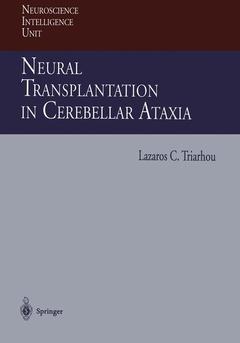Description
Neural Transplantation in Cerebellar Ataxia, Softcover reprint of the original 1st ed. 1997
Coll. Neuroscience Intelligence Unit
Author: Triarhou Lazaros
Language: French
Subject for Neural Transplantation in Cerebellar Ataxia:
Keywords
Publication date: 11-2013
162 p. · 17.8x25.4 cm · Paperback
162 p. · 17.8x25.4 cm · Paperback
Description
/li>Contents
/li>
erebellar ataxia is a failure in muscular coordination that re C sults from a slow, progressive deterioration of neurons in the cerebellum. An estimated 150,000 people are affected by the he reditary ataxias and related disorders in the United States. At present, there is no known cure. In an experimental treatment aimed at reconstructing the damaged pathway through exog enous neuronal supplementation, genetically ataxic mice have been used for intracerebral grafting of genetically healthy cerebellar neuroblasts, and evidence has been obtained for graft-induced en hancement of behavioral responses after bilateral cerebellar grafts. Such results are encouraging and underscore the potential of the neural grafting technique in restoring cerebellar function. How ever, many of the pathological and biochemical mechanisms in the interaction between grafted tissue and the host brain need to be further elucidated in extensive experimental studies, and great cau tion must be used in contemplating the theoretical feasibility of a possible application in humans.
1. Introduction.- 2. Cerebellar Structure and Development.- 3. The Human Cerebellar Ataxias.- 4. Cerebellar Mutants in the Laboratory Mouse.- 5. Neurological Mutant Mice as Genetic Models for Neuronal Transplantation.- 6. Basic Studies on Cerebellar Tissue Transplantation.- 7. Structural Integration of Cerebellar Grafts in Ataxic Mouse Mutants.- 8. Cerebellar Grafting and the Recovery of Function.- 9. Clinical Potential.
© 2024 LAVOISIER S.A.S.
These books may interest you

Cerebellar Disorders in Children 151.60 €



